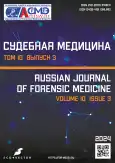炎热干旱区条件下心肌结构死后自溶变化的特征和变动
- 作者: Indiaminov S.I.1,2, Zhumanov Z.E.3, Blinova S.A.3
-
隶属关系:
- Republican Scientific and Practical Center for Forensic Medical Examination
- Tashkent Pediatric Medical Institute
- Samarkand State Medical Institute
- 期: 卷 10, 编号 3 (2024)
- 页面: 305-314
- 栏目: 原创研究
- URL: https://journal-vniispk.ru/2411-8729/article/view/267489
- DOI: https://doi.org/10.17816/fm15179
- ID: 267489
如何引用文章
全文:
详细
论证。确定死亡时间是对死于各种外部影响的人尸体进行法医学鉴定过程中的主要问题。最近,这个问题引起了法医学领域越来越多研究人员的关注,他们的工作重点是寻找解决这一复杂问题的新方法。
该研究的目的是揭示绞死后在不同阶段中心肌结构的自溶变化过程,从而确定死亡时间。
材料与方法。我们研究了 132 具因机械性上吊窒息而死亡人尸体的心肌组织学结构。死者中有 112 名男生和 20 名女生,年龄在 18 至 61 岁之间。死后时期从 6-14 小时到 72-76 小时不等,其中在 6.00-8.00(9.8%)、9.00-10.00(9.1%)、11.00-12.00(8.3%) 和 13.00-16.00(7.6%)时间间隔内发生的上吊案例最多。其他死后时期的案例占 6.8% 至 3.8%。在泽拉夫尚河山谷地区,包括乌兹别克斯坦的主要区域,一年中的高温季节通常持续 3.6 个月,从 5 月 27 日到 9 月 14 日,最高日平均气温至少为 28-32ºC。一年中的最热月份是 7 月,最高平均温度为 42-45ºC。寒冷季节平均持续 3.5 个月,从 11 月 25 日到次年 3 月 4 日,最低日平均气温低于 8-11ºC 。根据这一观察结果,死者被分为以下几组:在相对较低的环境温度(-7....+14℃)下死亡的—63 人;在中等温度(7-20℃)下死亡的—46 人;在高温(至少 25-30℃)下死亡的—23 人。除环境温度外,还考虑了其他因素:湿度、气压、风速等。
结果。在高气温条件下,绞死死亡后的心肌细胞从 9-10 小时开始出现自溶变化,到 25-28 小时,细胞溶解面积增加。在中等环境温度条件下,11-12 小时后观察到心肌细胞发生类似变化 ,25-28 小时后观察到心肌细胞干瘪;在低温条件下,13-14 小时和 25-28小时后分别观察到类似情况。在高温条件下,血管结构从死后 19-20 小时开始出现破坏性变化,这一时期血管周围空间明显扩大;在中温条件下,到21-22 小时出现这种情况;在低温条件下,23-24 小时后出现这种情况。在高温条件下,绞死后血管中的血液成分在死后 11-12 小时后发生自溶;在中温条件下,在 13-14 小时后发生自溶;在低温条件下,在 15-16 小时后发生自溶。因此,根据外部环境的温度条件,血管结构和心肌血管内成分的自溶变化会在不同死后期间发生。
结论。考虑到尸体现象发展程度的评估结果和超生反应的结果,给出的数据可用于法医学实践,根据干旱地区的温度条件确定绞死后的死亡时间。
作者简介
Sayit I. Indiaminov
Republican Scientific and Practical Center for Forensic Medical Examination; Tashkent Pediatric Medical Institute
编辑信件的主要联系方式.
Email: omadlikun@mail.ru
ORCID iD: 0000-0001-9735-0338
MD, Dr. Sci. (Medicine), Professor
乌兹别克斯坦, Tashkent; TashkentZiyadulla E. Zhumanov
Samarkand State Medical Institute
Email: omadlikun@mail.ru
ORCID iD: 0000-0002-7777-4288
Dr. Sci. (Philosophy), Assistant Professor
乌兹别克斯坦, SamarkandSofya A. Blinova
Samarkand State Medical Institute
Email: sofiya2709@mail.ru
ORCID iD: 0000-0002-9096-1774
MD, Dr. Sci. (Medicine), Professor
乌兹别克斯坦, Samarkand参考
- Buromsky IV, Sidorenko ES, Ermakova YuV. The current state of the establishment of prescription of death coming and the ways to its further. Forensic Medical Expertise. 2018;61(4):59–62. EDN: XYHFPN doi: 10.17116/sudmed201861459
- Bleshnikov IL, Belykh AN, Boldarian AA, et al. Forensic medicine: National guide. Ed. by Y.I. Pigolkin. Moscow: GEOTAR-Media; 2018. P. 26. (In Russ). EDN: IAIOGC
- Blair JA, Wang Hernandez D, Siedlak SL, et al. Individual case analysis of postmortem interval time on brain tissue preservation. PLoS One. 2016;11(3):0151615. doi: 10.1371/journal.pone.0151615
- Siddamsetty AK, Verma SK, Kohli A, et al. Estimation of time since death from electrolyte, glucose and calcium analysis of postmortem vitreous humor in semi-arid climate. Med Sci Law. 2014;54(3):158–166. doi: 10.1177/0025802413506424
- Tao L, Ma JL, Chen L. [Research progress on estimation of early postmortem interval. (In Chinese)]. Fa Yi XueZa Zhi. 2016;32(6):444–447. doi: 10.3969/j.issn.1004-5619.2016.06.013
- Zhu Y, Wang L, Yin Y, Yang E. Systematic analysis of gene expression patterns associated with postmortem interval in human tissues. Sci Rep. 2017;7(1):5435. doi: 10.1038/s41598-017-05882-0
- Vavilov AY, Malkov AV. Accounting for the «temperature plateau» as a condition for improving the accuracy of diagnosing the age of death. Meditsinskaya ekspertiza i pravo. 2012;(1):14–16. (In Russ). EDN: OXWMAN
- Lavrukova OS, Popov VL, Lyabzina SN, et al. The changes in the temperature of a corpse in the course of its decomposition (an experimental study). Forensic Medical Expertise. 2017;60(3):19–22. EDN: WHRJKO doi: 10.17116/sudmed201760319-22
- Pigolkin YuI, Korovin AA, Bogomolov DV, Bogomolova IN. Morphometric approaches to diagnosing the duration of death. Forensic Medical Expertise. 2001;44(1):3–6. EDN: YFKUBT
- Putintsev VA, Bogomolov DV, Sundukov DV. Morphological characteristics of different rates of dying. General Reanimatology. 2018;14(4):35–43. EDN: YYFLED doi: 10.15360/1813-9779-2018-4-35-43
- Hostiuc S, Rusu MC, Mănoiu VS, et al. Usefulness of ultrastructure studies for the estimation of the postmortem interval. A systematic review. Rom J Morphol Embryol. 2017;58(2):377–384.
- Yang AS, Quan GL, Gao YG, et al. Rectal temperature of corpse and estimation of postmortem interval. Fa Yi Xue Za Zhi. 2019;35(6):726–732. doi: 10.12116/j.issn.1004-5619.2019.06.015
- Viter VI, Kungurova VV, Korotun VN. Forensic histology: A manual for doctors. 4th ed., revised and updated. Perm; Izhevsk: Expertiza; 2011. 259 р. (In Russ).
- Indiaminov SI, Zhumanov ZE, Blinova SA. Problems of establishing the limitation of death. Forensic Medical Expertise. 2020;63(6):45–50. EDN: FXLSCS doi: 10.17116/sudmed20206306145
- Osmikin VA, Osmikin YuV. Issues of entomology in forensic medicine. In: Modern issues of forensic medicine and expert practice: A collection of scientific articles. Ed. by V.I. Viter. Issue 9. Izhevsk: Expertise; 1997. Р. 138–143. (In Russ).
- Li C, Li Z, Tuo Y, et al. MALDI-TOF MS as a novel tool for the estimation of postmortem interval in live tissue samples. Sci Rep. 2017;7(1):4887. doi: 10.1038/s41598-017-05216-0
- Zissler A, Ehrenfellner B, Foditsch EE, et al. Does altered protein metabolism interfere with postmortem degradation analysis for PMI estimation? Int J Legal Med. 2018;132(5):1349–1356. doi: 10.1007/s00414-018-1814-8
- Babkina EP, Dolotin SA. The determination of depending on the duration of injury and time of death the dynamics of changes in the temperature characteristics of the liver. Russ J Forensic Medicine. 2017;3(4):8–11. EDN: ZXYEUX doi: 10.19048/2411-8729-2017-3-4-8-11
- Akopov VI. Forensic medicine: Textbook for bachelors. 3rd ed., revised and updated. Moscow: Yurait; 2016. 478 р. (In Russ).
- Kuzovkov AV. Determination of the age of human death by non-invasive thermometric method [dissertation abstract]: 14.03.05. Place of defence: Moscow State Medical and Dental University named after A.I. Evdokimov. Izhevsk; 2017. 23 р. (In Russ).
- Naumenko VG, Mityaeva NA. Histological and cytological methods of research in forensic medicine: Manual. Moscow: Medicine; 1980. 304 p. (In Russ).
补充文件









